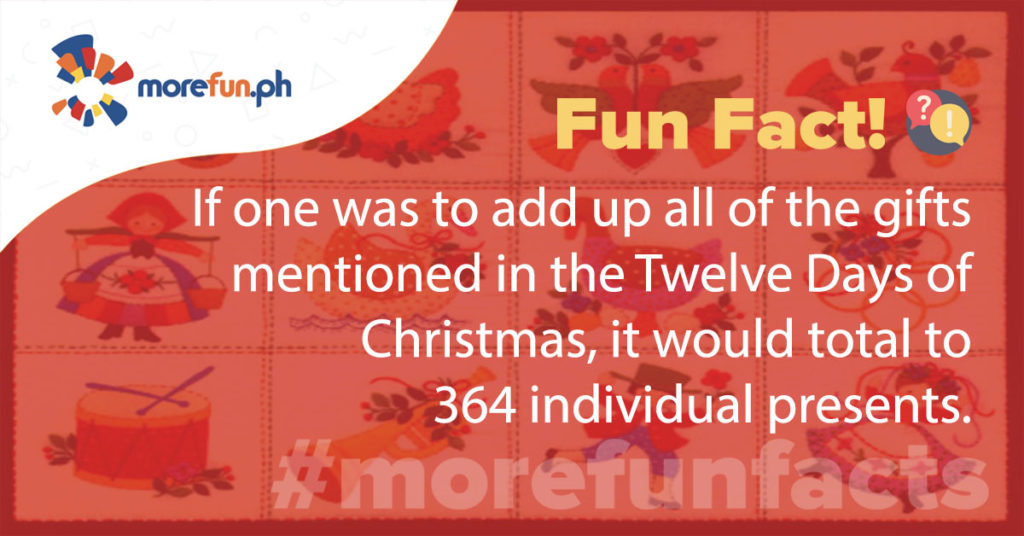The Twelve Days of Christmas
One of the oft-repeated carols around the world is the Twelve Days of Christmas but what is it really about? What even are the twelve days referred to in the song? Does it come before or after Christmas day? And what kind of animals are calling birds?
Well, aside from the obvious (that the song is about someone getting a boatload of presents from her / his true love), the song is believed (by some) to be about the the twelve days that follow December 24, Christmas eve. The twelve days each celebrates either a saint or an otherwise important personage in the Catholic faith.
Day one (December 25) is, of course, Christmas Day which celebrates the birth of Jesus in Bethlehem. Day two (December 26) is St. Stephen’s Day, a man who is said to be the first Christian Martyr. It is also the date when Boxing Day is celebrated, which is when the alms and collection boxes kept by churches are opened so that the contents could be distributed among poor people. Day 3 (December 27) is dedicated to St. John the Apostle, one of the twelve apostles of Jesus. He is believed to be the apostle that outlived the other eleven and the sole one who died of natural causes. Day 4 (December 28) is the Feast of the Holy Innocents, the day that memorializes the male infants that were slain by King Herod of Judea during his attempt to find and kill the infant Jesus.
Day 5 (December 29) is the day that commemorates St. Thomas Beckett, who was the Archbishop of Canterbury in the 12th century. He was in conflict with King Henry II over the rights and privileges of the Church and was eventually murdered by followers of the king in Canterbury Cathedral. Day 6 (December 30) is dedicated to St. Egwin of Worcester. He was a Benedictine monk and later Bishop of Worcester. He was known as a protector for orphans and the widowed. Day 7 (December 31) in addition to celebrating New Year’s Eve, is also reserved for Pope Sylvester I. In fact, in many central and eastern European countries, New Year’s Eve is called “Silvester”.
Day 8 (January 1) is New Year’s Day and devoted to Mary, Mother of Jesus. She is widely believed to have conceived the messiah while a virgin by the Holy Spirit. The miraculous conception took place while she was already betrothed to Joseph. After their marriage, Joseph accompanied her to Bethlehem where Jese was born. Day 9 (January 2) is both dedicated to St. Basil the Great and St. Gregory Nazianzen. St Basil was largely responsible for establishing guidelines for monastic life (focus on community life, liturgical prayer, and manual labor) while St. Gregory’s work is a major influence in the study of the Christian doctrine of the Trinity.
Day 10 (January 3) is the Feast of the Holy Name of Jesus. As the appellation implies, it venerates the naming of the child Jesus with the “name given by the angels before he was conceived in the womb”. Day 11 (January 4) is St. Elizabeth Ann Seton’s Day. St Elizabeth was the first native born citizen of the United States to be sainted by the Church. It was largely thanks to her efforts that several congregations in the United States and Canada exist to this day. Members of these congregations work tirelessly on the unmet needs of impoverished people around the world.
And finally Day 12 (December 5) is dedicated to St. John Neumann, the first US Bishop. In addition, Neumann was also the founder of first Catholic diocesan school system in the United States. In the Philippines, as well as many Latin American countries, this is the day when we celebrate the Feast of Three Kings (also known as Epiphany Eve).
As for the gifts named in the song, one explanation is that they profess religious faith. According to the interpretation, the partridge in a pear tree is Jesus while the two turtledoves are the Old and New Testaments. The three French hens stand for faith, hope and love. The four calling birds are the four Gospels. The five gold rings are the Pentateuch (the first five books of the Old Testament). The six geese a-laying represent the six day of creation.
The seven swans a-swimming stand for the seven gifts of the Holy Spirit (wisdom, understanding, counsel, fortitude, knowledge, piety and fear of the lord). The eight maids a-milking are the eight Beatitudes. The nine ladies dancing are the nine fruits of the Holy Spirit (love, joy, peace, patience, kindness, goodness, faithfulness, gentleness, and self-control). The ten lords a-leaping are the Ten Commandments. The eleven pipers piping represent the eleven faithful apostles. And lastly, the twelve drummers drumming represent the twelve points of doctrine in the Apostles’ Creed.
So, what then are calling birds? According to scholars, it may very well be a mispronunciation of the original version which might have been “colly birds” or “collie birds”, both of which are archaic terms for blackbirds.
Most interestingly, if one was to try and purchase all the items named in the song, it would cost a grand total of US$ 34,558.65. The financial institution PNC Wealth Management has been publishing the cost of buying all the things mentioned in the Twelve Days of Christmas every year since 1984.
